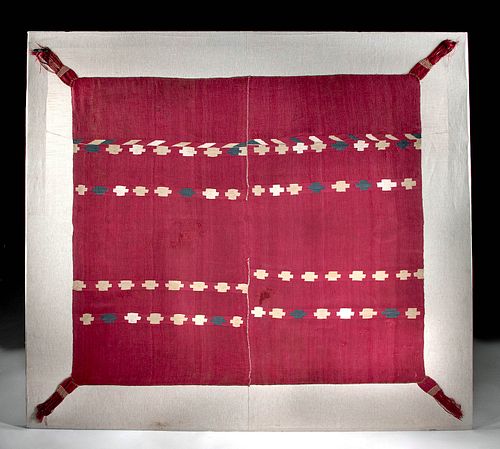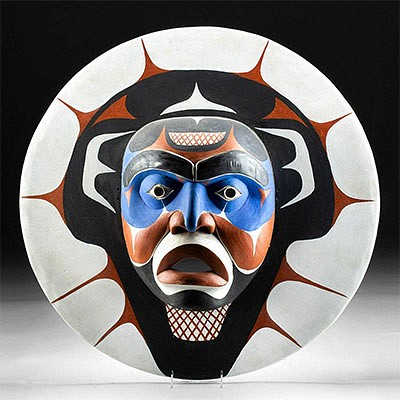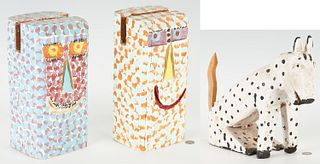Huge Inca Polychrome Tunic w/ Geometric Motifs
Lot 17a
About Seller
Artemis Gallery
686 S Taylor Ave, Ste 106
Louisville, CO 80027
United States
Selling antiquities, ancient and ethnographic art online since 1993, Artemis Gallery specializes in Classical Antiquities (Egyptian, Greek, Roman, Near Eastern), Asian, Pre-Columbian, African / Tribal / Oceanographic art. Our extensive inventory includes pottery, stone, metal, wood, glass and textil...Read more
Estimate:
$7,000 - $10,000
Absentee vs Live bid
Two ways to bid:
- Leave a max absentee bid and the platform will bid on your behalf up to your maximum bid during the live auction.
- Bid live during the auction and your bids will be submitted real-time to the auctioneer.
Bid Increments
| Price | Bid Increment |
|---|---|
| $0 | $25 |
| $300 | $50 |
| $1,000 | $100 |
| $2,000 | $250 |
| $5,000 | $500 |
| $10,000 | $1,000 |
| $20,000 | $2,500 |
| $50,000 | $5,000 |
| $100,000 | $10,000 |
| $200,000 | $20,000 |
About Auction
By Artemis Gallery
Mar 18, 2021
Set Reminder
2021-03-18 10:00:00
2021-03-18 10:00:00
America/New_York
Bidsquare
Bidsquare : Pre-Columbian | Tribal | Oceanic
https://www.bidsquare.com/auctions/artemis-gallery/pre-columbian-tribal-oceanic-6520
Featuring Pre-Columbian, Native American, African / Tribal, Oceanic, much more. All items have been legally acquired and are legal to sell. Convenient in-house shipping. Artemis Gallery info@artemisgallery.com
Featuring Pre-Columbian, Native American, African / Tribal, Oceanic, much more. All items have been legally acquired and are legal to sell. Convenient in-house shipping. Artemis Gallery info@artemisgallery.com
- Lot Description
Pre-Columbian, central highlands of Peru, Inca culture, ca. 1350 to 1500 CE. A massive textile tunic composed of two broad camelid fiber panels that are dyed in an attractive crimson hue. The seam running down the middle is sewn together except in the center where a slit-form opening is situated through which one would place their head. Decorating the tunic panels are columns of beige, yellow, white, and dark blue rectangles with petite nodules protruding from the ends, and a column of trapezoidal forms is mirrored on one side. Each corner is adorned with a thick tassel embellished with a striated, ladder-form bar of beige thread. Mounted against a museum-quality display panel. Size (tunic without tassels): 60.375" W x 56.3" H (153.4 cm x 143 cm); (display panel): 77" W x 73.1" H (195.6 cm x 185.7 cm)
Weaving was among the Incas' greatest arts. They used cotton as well as soft wool of the alpaca and the vicuna, the smallest camelid of the Americas. Inca tunics, known as 'unku' in the Quechua language, are masterworks of weaving made by skilled artisans using looms as wide as the tunics themselves. Tunics were attire for elite men, and their ownership was restricted by the rigidly hierarchical Inca state. Many were given as gifts by the emperor to reward military service or some other form of loyalty. The preservation of Andean textiles is a product of both the dry desert climate of the area and traditional burial practices whereby bodies of the deceased were wrapped in several layers of cloth to make mummy bundles. This is a rare, complete, well preserved example.
Provenance: ex-private C. Webster collection, Santa Fe, New Mexico, USA, acquired before 2000; ex-Mark Winter collection
All items legal to buy/sell under U.S. Statute covering cultural patrimony Code 2600, CHAPTER 14, and are guaranteed to be as described or your money back.
A Certificate of Authenticity will accompany all winning bids.
We ship worldwide and handle all shipping in-house for your convenience.
#155850Repairs to several areas with red thread, with a few larger areas backed with modern red fabric for presentation purposes. Light fraying to some interior, peripheral, and tassel threads, with minor fading and staining to color in scattered areas, and light creasing. Great remains of geometric motifs and colors throughout.Condition
- Shipping Info
-
All shipping is handled in-house for your convenience. Your invoice from Artemis Gallery will include shipping calculation instructions. If in doubt, please inquire BEFORE bidding for estimated shipping costs for individual items.
-
- Buyer's Premium



 EUR
EUR CAD
CAD AUD
AUD GBP
GBP MXN
MXN HKD
HKD CNY
CNY MYR
MYR SEK
SEK SGD
SGD CHF
CHF THB
THB















